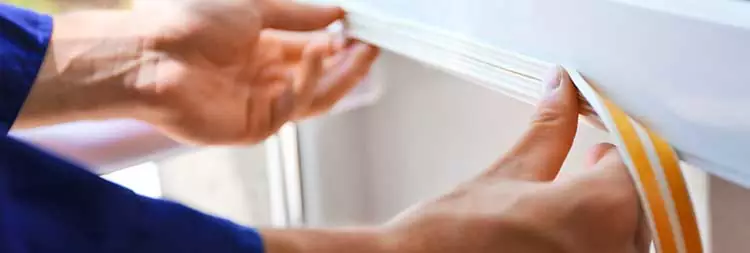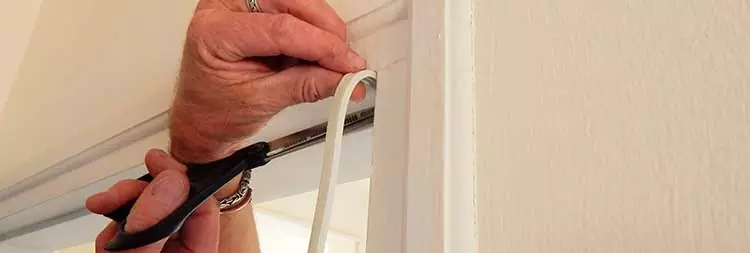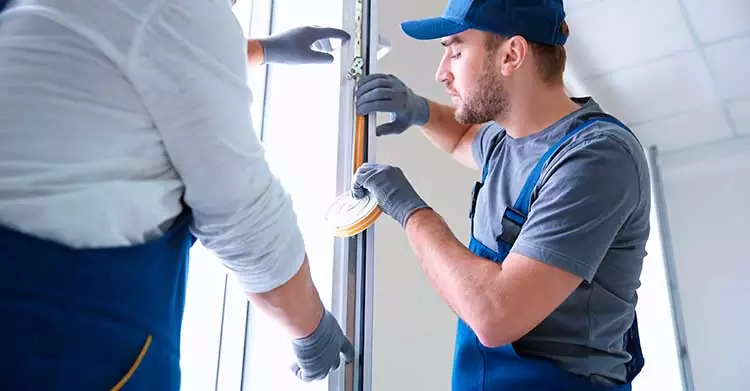When it comes to effectively sealing gaps from your exterior and front doors, you can never go wrong by weatherstripping them. For this reason, we’ll show you which are the main types of weather stripping.
Today, we will show you the different weather stripping types, going over the material, its best uses, and more. So keep reading to find out!
What Is Weather Stripping?
With the holiday season coming soon, more and more businesses are looking for ways to keep their clients warm and safe inside their stores.
While there are many people who choose to opt to replace their doors, this alternative can be too costly for many businesses. Luckily, this is where weatherstripping comes in real handy.
The goal of weatherstripping is simple: to keep snow and rain out while at the same time not letting any interior air escape. The result: a sealed door that cuts down your energy bill costs up to 15%! Additionally, this option helps reduce outside noise as well.
Moreover, weather stripping installation is often around any openings a place may have in which air leaks are more prone to happen. For this reason, it’s mostly used for exterior doors, windows, garage doors, and any type of door that leads to an area where there’s no HVAC.
Additionally, its most common materials include vinyl, rubber, EPDM, vinyl tubing, and metals.
Which Are the Main Types of Weather Stripping for Doors?
If you want to get the best out of weatherstripping, you must make sure to choose the right type. After all, with so many styles and materials out there in the market, it’s normal not to know which one to go for.
That’s why we decided to make this guide to the different options out there for commercial enterprises.
These are the main types of weather stripping to keep in mind:
- Plain or reinforced felt weatherstrip
- Metal weatherstripping
- V-Strips (tension seal or tension strips)
- Plastic, aluminum, and stainless steel door sweeps
- Foam tape from EPDM rubber or closed-cell foam
- Rubber weather stripping
Plain or Reinforced Felt Weatherstrip

Among the most common types of weather stripping for doors out there, you can find felt weather-stripping in stores sold in rolls. This type of weatherstripping can be made out of cotton, polyester, and wool and has a metal strip for reinforcement.
When applying this felt gasketing, professionals tend to vary using glue, staples, and tacks. Moreover, this material is usually the go-to option for windows and doors’ jambs.
Felt weatherstripping typically lasts between one or two years.
The best thing about this weatherstripping type is that it is incredibly affordable and available for everyone. Not only that, but it’s also easy to install, thus resulting in you in lower installation costs.
Metal Weatherstripping
If you’re looking for an option that’ll last you decades, then you should definitely consider metal weatherstripping.
This type of weather stripping endures the most intense of climates, including strong winds and harsh freezing temperatures. Moreover, wooden doors tend to slide smoother with this material choice.
While it’s a little bit more expensive and difficult to install, this gasket option surely pays off the price.
With metal weather stripping, you can opt for various types of metals, including zinc, aluminum, and steel.
V-Strips (Tension Seal or Tension Strips)
Tensions strips (a.k.a. V-strips or tension strips) are plastic seal strips that are usually self-stick. Having a V strip helps create a protective door seal that blocks air drafts. This means that neither cold air will be coming in nor warm air will be coming out.
This type of gasketing is installed on the top and sides of doors and windows. You can install it quickly, just cutting the length you need with scissors. Because of its self-stick feature, you’ll need nothing else to fix it.
Plastic, Aluminum, and Stainless Steel Door Sweeps
Following our list of types of weather stripping for doors, we have door sweeps.
Usually made of plastic, aluminum, or stainless steel with a vinyl sponge attached, door sweeps are quite common for stores. This is because they do their job when it comes to filling the space between the threshold and the bottom of the door.
Door sweeps are among the easiest options out there for installation.
All you’ll need is a pencil, a tape measurer, and scissors. You’ll first measure your door. After getting the right measurements, you’ll cut the strip the size you need it. Last but not least, you’ll place the door sweep with the vinyl sponge touching the threshold.
Of course, this type of gasketing is mainly for doors. These are usually installed in the bottoms and sides of doors. When installing automatic door sweeps, you’ll save yourself from the trouble of the sweep dragging your carpet.
Foam Tape from EPDM Rubber or Closed-Cell Foam

Have you heard of EDPM before?
If not, then allow us to illustrate to you. EPDM is a long-lasting type of rubber that’s mainly used for roofs. Now imagine a kind of weather stripping for doors that comes from this material.
That’s precisely what foam seal tape is!
With this type of gasketing, your doors will have the same kind of protection many flat roofs have! Your doors will have years of safety and security. Not only that but also your place will count on heat and sound insulation as well!
Foam weatherstripping comes in all types of widths and thicknesses. This makes it perfect for uneven cracks and spaces.
This weatherstripping can be used in all sorts of doors and windows. Some of the most common uses are window sashes, storm windows and doors, non-opening windows, and attic hatches.
Tubular Rubber and Vinyl Weather Stripping
Usually applied around doors, this type of weather stripping for doors is among the most difficult to place. Rubber and vinyl door gasketing come with either a wood or a metal strip.
You can find tubular rubber and vinyl in your general hardware store. Sadly, its price ranges higher compared to other weather-stripping materials. Not only that, but it also can be somewhat of a challenge for when it comes to installing it.
Tubular rubber and vinyl gasketing, however, can be long-lasting. Its lifespan is that of 5 years! Last but not least, it grants your doors an incredible air barrier. In other words, you’ll have fewer air leaks, thus meaning lower electricity bills!
To Sum All Up…

Weatherstripping brings wonders to businesses during winter. It keeps stores warm by granting you a seal-tight door free of air leaks.
A few tips to keep in mind when installing weatherstripping to your doors include cleaning and drying the surface area in which the weatherstrip will be. Along with that, you need to make sure to measure the area before making a cut!
So there you have it! Five types of weather stripping for doors!
In case you don’t want to go through all of the trouble of installing any of these materials onto your doors and windows, then you can always contact a professional!
The Integral Role of Commercial Door Weather Stripping and Their Importance
weather stripping and their importance” stems from their multifaceted role in business operations, directly impacting factors like energy conservation, interior comfort, and security.
These stripping materials, usually made from rubber, foam, or vinyl, create a tight seal between the door and its frame. This not only prevents air leaks, thereby maintaining internal temperatures and reducing energy consumption. Importantly it also keeps out water, pests, and pollutants. For businesses, this means reduced utility bills, a safer, more comfortable environment for staff and visitors, and an extension in the lifespan of HVAC systems due to reduced workload.
Diving Deeper into Commercial Door Weather Stripping and Their Importance
Energy Efficiency and Cost Savings
One of the most compelling arguments for “commercial door weather stripping and its importance” is the immediate impact on energy efficiency. Properly installed weather stripping prevents the leakage of conditioned air, thereby significantly reducing the energy required to heat or cool a commercial space. This conservation of energy translates directly into cost savings, reducing a company’s overhead expenses.
Enhanced Comfort for Occupants
Weatherstripping also plays a pivotal role in maintaining a comfortable interior climate. Sealing gaps and preventing drafts ensures a consistent temperature, thereby enhancing the comfort level for employees and customers alike. This can improve employee productivity and customer satisfaction, indirectly boosting the business’s success.
Protection Against the Elements
The importance of commercial door weather stripping extends to protecting the interior of buildings from the elements. It prevents moisture, dirt, and even pests from entering, which can be crucial in maintaining the integrity of the property and the health of those inside.
Noise Reduction
An often overlooked advantage is noise reduction. Weather stripping can provide a sound barrier, reducing the noise pollution penetrating commercial spaces, particularly important in areas with heavy traffic or industrial noise.
Longevity of Commercial Doors
Proper weather stripping protects the doors themselves. By providing a buffer against moisture and temperature fluctuations, weather stripping can extend the life of commercial doors, reducing the frequency and costs of repairs or replacements.
Professional Installation: A Key Factor
Finally, the effectiveness of weather stripping significantly depends on proper installation. Professional installation ensures an exact fit and optimal performance, underscoring the need for expertise in this seemingly minor yet critical component of a commercial property’s infrastructure.
Practical Tips for Maintaining Weather Stripping
- Regularly inspect the weather stripping for wear and tear, especially during extreme weather conditions.
- Clean the weather strips periodically to remove dirt and debris, which can affect their efficiency.
- Replace weather stripping when it becomes compressed, brittle, or torn to maintain optimal performance.
Facts About Weather Stripping
- Weatherstripping materials can vary significantly in terms of durability and performance. For example, vinyl holds up well in extreme temperatures, while foam is more affordable but less durable.
- Proper weather stripping can reduce energy bills by up to 20%, showcasing its impact on operational costs.
- Weatherstripping conserves energy and contributes to a business’s sustainability goals by reducing its carbon footprint.
Common Questions About Commercial Door Weather Stripping
How often should weather stripping be replaced?
This depends on the material and usage, but generally, it should be checked annually and replaced every few years or when signs of wear are evident.
Can weather stripping be installed on all types of commercial doors?
Yes, weather stripping is versatile and can be fitted to various door types, including metal, wood, and glass doors.
Does weather stripping require professional installation?
While some businesses opt for a DIY approach. Professional installation is recommended to ensure the most effective seal and the best energy-saving outcomes.
IN NEED OF WEATHER STRIPPING FOR DOORS FOR YOUR CHICAGO BUSINESS?
Here at the Chicago Door People, we know how important it is for business owners to keep their stores ready for any time of year. That’s why we offer a great variety of door services, including commercial door and revolving door installation, hollow metal door frames, and, of course, door weather stripping in Chicago.
You can claim your free quote by calling our team today!

